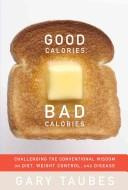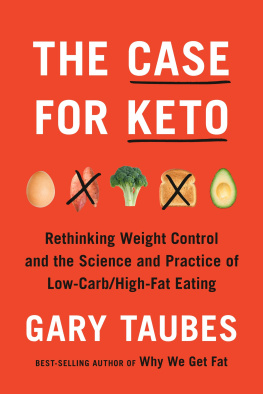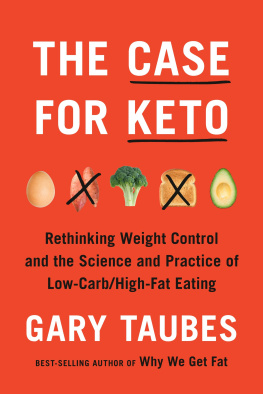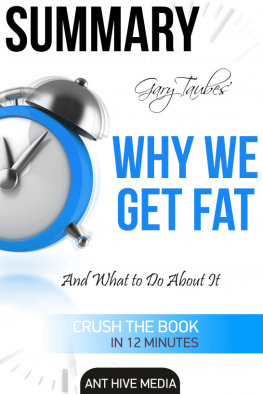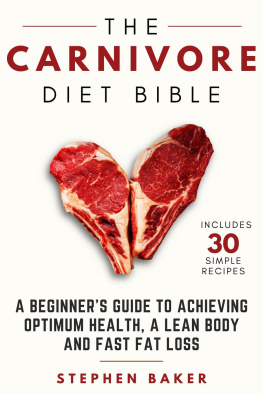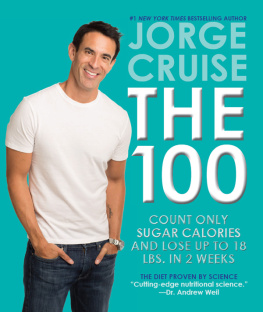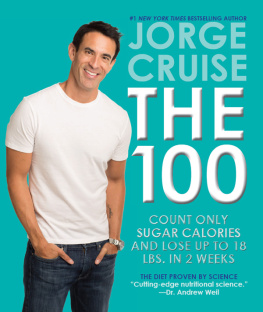

Contents
Title Page
Dedication
Prologue A Brief History of Banting
Part One
THE FAT-CHOLESTEROL HYPOTHESIS
1 The Eisenhower Paradox
2 The Inadequacy of Lesser Evidence
3 Creation of Consensus
4 The Greater Good
Part Two
THE CARBOHYDRATE HYPOTHESIS
5 Diseases of Civilization
6 Diabetes and the Carbohydrate Hypothesis
7 Fiber
8 The Science of the Carbohydrate Hypothesis
9 Triglycerides and the Complications of Cholesterol
10 The Role of Insulin
11 The Significance of Diabetes
12 Sugar
13 Dementia, Cancer, and Aging
Part Three
OBESITY AND THE REGULATION OF WEIGHT
14 The Mythology of Obesity
15 Hunger
16 Paradoxes
17 Conservation of Energy
18 Fattening Diets
19 Reducing Diets
20 Unconventional Diets
21 The Carbohydrate Hypothesis I: Fat Metabolism
22 The Carbohydrate Hypothesis, I : Insulin
23 The Fattening Carbohydrate Disappears
24 The Carbohydrate Hypothesis I I: Hunger and Satiety
Epilogue
Notes
Bibliography
Acknowledgments
Illustration Credits
A Note About the Author
Also by Gary Taubes
Copyright
FOR
SLOANE AND HARRY, MY FAMILY
Prologue
A BRIEF HISTORY OF BANTING
Farinaceous and vegetable foods are fattening, and saccharine matters are especial y so. In sugar-growing countries the negroes and cattle employed on the plantations grow remarkably stout while the cane is being gathered and the sugar extracted. During this harvest the saccharine juices are freely consumed; but when the season is over, the superabundant adipose tissue is gradual y lost.
THOMAS HAWKES TANNER, The Practice of Medicine, 1869
WILLIAM BANTING WAS A FAT MAN. In 1862, at age sixty-six, the five-foot-five Banting, or Mr. Banting of corpulence notoriety, as the British Medical Journal would later cal him, weighed in at over two hundred pounds. Although no very great size or weight, Banting wrote, stil I could not stoop to tie my shoe, so to speak, nor attend to the little offices humanity requires without considerable pain and difficulty, which only the corpulent can understand. Banting was recently retired from his job as an upscale London undertaker; he had no family history of obesity, nor did he consider himself either lazy, inactive, or given to excessive indulgence at the table. Nonetheless, corpulence had crept up on him in his thirties, as with many of us today, despite his best efforts. He took up daily rowing and gained muscular vigor, a prodigious appetite, and yet more weight. He cut back on calories, which failed to induce weight loss but did leave him exhausted and beset by boils. He tried walking, riding horseback, and manual labor. His weight increased. He consulted the best doctors of his day. He tried purgatives and diuretics. His weight increased.
Luckily for Banting, he eventual y consulted an aural surgeon named Wil iam Harvey, who had recently been to Paris, where he had heard the great physiologist Claude Bernard lecture on diabetes. The liver secretes glucose, the substance of both sugar and starch, Bernard had reported, and it was this glucose that accumulates excessively in the bloodstream of diabetics. Harvey then formulated a dietary regimen based on Bernards revelations. It was wel known, Harvey later explained, that a diet of only meat and dairy would check the secretion of sugar in the urine of a diabetic. This in turn suggested that complete abstinence from sugars and starches might do the same. Knowing too that a saccharine and farinaceous diet is used to fatten certain animals, Harvey wrote, and that in diabetes the whole of the fat of the body rapidly disappears, it occurred to me that excessive obesity might be al ied to diabetes as to its cause, although widely diverse in its development; and that if a purely animal diet were useful in the latter disease, a combination of animal food with such vegetable diet as contained neither sugar nor starch, might serve to arrest the undue formation of fat.
Harvey prescribed the regimen to Banting, who began dieting in August 1862. He ate three meals a day of meat, fish, or game, usual y five or six ounces at a meal, with an ounce or two of stale toast or cooked fruit on the side. He had his evening tea with a few more ounces of fruit or toast. He scrupulously avoided any other food that might contain either sugar or starch, in particular bread, milk, beer, sweets, and potatoes. Despite a considerable al owance of alcohol in Bantings regimen
four or five glasses of wine each day, a cordial every morning, and an evening tumbler of gin, whisky, or brandyBanting dropped thirty-five pounds by the fol owing May and fifty pounds by early 1864. I have not felt better in health than now for the last twenty-six years, he wrote. My other bodily ailments have become mere matters of history.
We know this because Banting published a sixteen-page pamphlet describing his dietary experience in 1863Letter on Corpulence, Addressed to the Public promptly launching the first popular diet craze, known farther and wider than Banting could have imagined as Bantingism. His Letter on Corpulence was widely translated and sold particularly wel in the United States, Germany, Austria, and France, where according to the British Medical Journal, the emperor of the French is trying the Banting system and is said to have already profited greatly thereby. Within a year, Banting had entered the English language as a verb meaning to diet. If he is gouty, obese, and nervous, we strongly recommend him to bant,
suggested the Pall Mall Gazette in June 1865.
The medical community of Bantings day didnt quite know what to make of him or his diet. Correspondents to the British Medical Journal seemed occasional y open-minded, albeit suitably skeptical; a formal paper was presented on the efficacy and safety of Bantings diet at the 1864 meeting of the British Medical Association. Others did what members of established societies often do when confronted with a radical new concept: they attacked both the message and the messenger. The editors of The Lancet, which is to the BMJ what Newsweek is to Time, were particularly ruthless. First, they insisted that Bantings diet was old news, which it was, although Banting never claimed otherwise. The medical literature, wrote The Lancet, is tolerably complete, and supplies abundant evidence that al which Mr. Banting advises has been written over and over again. Banting responded that this might wel have been so, but it was news to him and other corpulent individuals.
In fact, Banting properly acknowledged his medical adviser Harvey, and in later editions of his pamphlet he apologized for not being familiar with the three Frenchmen who probably should have gotten credit: Claude Bernard, Jean Anthelme Bril at-Savarin, and Jean-Franois Dancel. (Banting neglected to mention his countrymen Alfred Wil iam Moore and John Harvey, who published treatises on similar meaty, starch-free diets in 1860 and 1861 respectively.) Bril at-Savarin had been a lawyer and gourmand who wrote what may be the single most famous book ever written about food, The Physiology of Taste, first published in 1825.*1 In it, Bril at-Savarin claimed that he could easily identify the cause of obesity after thirty years of talking with one fat or particularly fat individual after another who proclaimed the joys of bread, rice, and potatoes. He added that the effects of this intake were exacerbated when sugar was consumed as wel . His recommended reducing diet, not surprisingly, was more or less rigid abstinence from everything that is starchy or floury.
Next page
